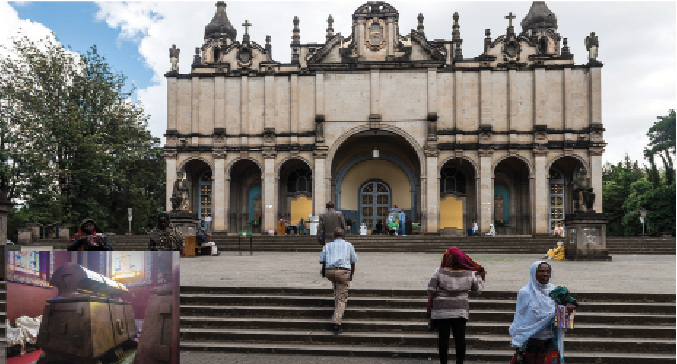In the concluding part of this travelogue, Ikechi Uko recounts to Special Correspondent, RENN OFFOR, his discovery of amazing African history in Ethiopia he had never heard of.
Dating back 3,000 years
Ethiopia is one of the world’s most culturally unique countries, due to its long history and protracted years of separation from the external world. It was never colonised by a European power.
Its more than 3,000 years of unbroken history leaves for tourists many interesting remains which teach much about Ethiopian culture and its change through time.
Single rock art is prevalent. Examples are the Obelisks of Aksum (400 AD), Rock Hewn churches of Lalibela (1200 AD), and Tigray Rock churches.
The Orthodox Christian tradition goes back to 300 AD undisturbed. If you can get permission, it is truly an experience to watch one of their 12-hour plus ceremonies. Such experiences are found all over the northern part of the country.
There are many places to hike and camp, where you can really get away from power lines and Coca-Cola and be in the wilderness. The Nile Gorge and the Simeon Mountains are just two.
Endemic animal and plant species abound.
The more than 80 different languages spoken throughout the country testify to the richness of its culture and freedom of self-expression. The Omo Valley is rich in the “primitive” lifestyle of the tribes.
Ethiopia has its own unique language characters with which it effectively expresses its culture, and celebrates festivals and holidays following its own unique calendar.
Tourists are especially recommended to visit at Genna (Ethiopian Christmas), which falls on January 7; and at Timket (Ethiopian Epiphany), held on January 19.
Churches, restaurants
We started the day in Addis Ababa riding the open roof city bus. We ate lunch at Lucy Restaurant, a nice place to eat; visited the museum, and ended up in the Holy Trinity Church where Haile Selasie is entombed.
At the church, I met Hapte-Selassie Tafesse, reputed to be the father of tourism in Ethiopia. He came for prayers. Ethiopians are permanently worshipping.
The evening ended with entertainment at Yod Abyssinia Cultural Restaurant.
The Church of St. Mary was first built in Axum in the 300s AD.
In 1635, it was reconstructed by Fasilidas. In 1955, to mark his Silver Jubilee, Selassie founded a new Church of St. Mary of Zion next to the old one. It was completed in 1964.
Selassie interrupted the state visit to Ethiopia of Queen Elizabeth II of England to attend the dedication of the cathedral. Elizabeth visited St. Mary of Zion herself a few days later.
In 1965, Selassie built a relic chapel next to Old St. Mary’s to hold the church treasures and the revered Ark of the Covenant.
The new St. Mary of Zion is modern in its architecture, more spacious, and decorated with colorful art. It was built in a modern interpretation of the Greek Byzantine style with Ethiopian influences.
A large painting in the front of the church depicts the Holy Trinity, the Twelve Apostles, and the Twelve Tribes of Israel.
Axum was the first Christian kingdom in the world and the largest outside the Roman Empire. Situated on the caravan trade routes to Arabia, Nubia, and Egypt, Axum traded as far away as Greece, Rome, and Constantinople.
Coffee, flowers, and Abebe
Ethiopia gave the world coffee. It is the largest exporter of coffee in Africa. And it is the second largest exporter of flowers in Africa after Kenya.
The flower business is dominated by Ecuador and Colombia. Ethiopia sells $200 million of flowers every year through auctions in The Netherlands.
I attended a flower show by Ethiopian producers for Japanese buyers.
Ethiopia sells 25,000 tonnes of coffee every year to Japan but sells only 10 million flower stems to Japan, which is 0.8 per cent of the 1.2 billion flower stems that country imports every year.
Ethiopia offers the Japanese more flowers, citing the diversity of its flowers. It has the big headed flowers from the highlands and small headed flowers from the lowlands.
Ethiopia offers the Japanese flowers, coffee, tourism – and Bikila Abebe, a marathoner who won two Olympic gold medals at the 1964 Olympics in Tokyo. He has since become the bridge between Japan and Ethiopia.
Islamic roots
I may never go to Mecca but I have visited one the most revered places in Islam.
Muslims were being persecuted in Arabia and Mohammed sent his wife and daughter along with 14 other people to seek refuge in the Christian kingdom of Abyssinia, known to have a just king.
The journey was undertaken just before Hijrah, Mommed’s flight from Mecca to Medina.
The king accommodated them in Nagash where they built a mosque. The mosque today is under renovation by the Turkish government. The mausoleum where the Hijrams were buried is also under renovation.
Stumble on rich African history
Before arriving Nagash we had to pass through a death defying road through the mountains to Yeha.
The twists and turns through the Great Rift Valley present probably the scariest drive you can have. The road has more than 100 turns going up and down.
Yeha is the site of an ancient Sabean temple built millennia before Jesus Christ. It later became a Church. Its early monks recorded stories of three monks said to have been taken up to heaven while praying.
Amazing history I never ever heard of.
Today shows the importance of Ethiopia in the history of religion and the world. The earliest Christian churches together with the Ark of the Covenant held by the Jewish Solomonic dynasty and, now, the first mosque in Africa.
What a day driving from Axum through Nagash to Mekelle.
A field full of giant obelisks known more as stelae reveals a civilisation so advanced and organised it rivals those of Egypt and Greece. How come most of us know next to nothing about Ethiopia and its great past?
Stelaes are signposts of royal tombs below. Built some 2,000 years ago, some as recently as 1000 years ago, they are as heavy as 50 tonnes and as tall as 33 metres.
They are so impressive Ducce Mussolini of Italy stole one in the invasion of Ethiopia. It was returned in 2005.
Visiting the ruins of the palace of the queen of Sheba revealed so much of what is hidden beneath the rubble. The palace has been dated to 10 BC.
Menelik, the son she reportedly had for Solomon, created the Solomonic dynasty that ended after over 200 kings, climaxing at the death of Selasie.
Lots of stories I have never heard. I felt so ignorant. Africa is rich in history.
I was told that only about 10 per cent of Ethiopia has been excavated and studied by archaeologists. I met one of the archaeologists, a young lady from America, digging around Adwa. I am getting enriched in knowledge about our great African ancestors.
A priest, a king, and a great engineer
After arriving Lalibela on the early morning flight from Addis Ababa I had to do a picture with the young captain of the Dash 8.
We ran into three Coptic bishops at the rock hewn churches of Lalibela. Two are Egyptian Coptic bishops from New York and Florida, the third is from Ethiopia.
They came with members of their churches for missionary work. We watched the bishops conduct services in English and Arabic. I was surprised to hear Christian songs in Arabic sounded like a Jewish worship session.
An interesting day it was for the group of Nigerian travel agents on tour of Ethiopia.
Lalibela, who built these 12 churches over 23 years, was a king, a priest, and a great engineer.
I jokingly remarked that he must have descended from Melchizedek of the Bible who was a king and a priest. I also tried measuring height with the most famous of the 12 churches of St Georges.
There are three sets of churches.
The first set is the churches of the New Jerusalem, which symbolises some stories of the Old Testament.
The second represents the Heavenly Jerusalem, mostly stories of the New Testament.
The third set includes the Church of St. Georges, which represents Noah’s Ark.











